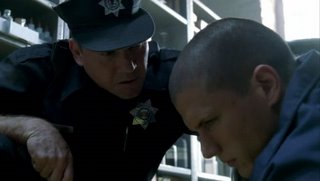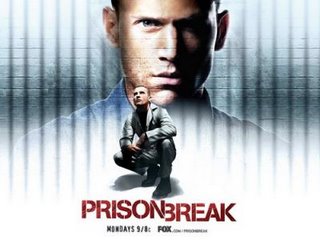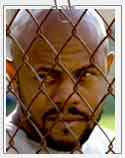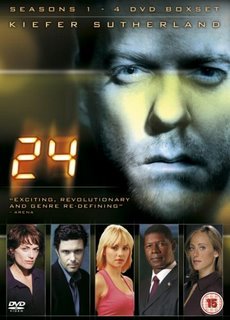'Prison Break': Sharpen Up Those Spoons
By Tom ShalesWashington Post Staff WriterMonday, August 29, 2005; Page C01
Fox, let's face it, has a slight sadistic streak. How else to explain the network's obsession with starting the new TV season earlier and earlier each year? Of course, "new TV season" has been an anachronistic term for a decade or so -- what with cable and broadcast shows coming and going at virtually any time -- but when the early birds are as punishingly junky as Fox's "Prison Break," it's only natural to suspect some sort of vendetta at work.
An old industry cliche maintains that "no one sets out to make a bad TV show," but it's certainly the easiest explanation for something as pitifully awful as this thing.
"Prison Break" deals with a vast and sinister conspiracy and also appears to be part of one. It's 3-B TV:
Boring Beyond Belief, a hideous hybrid that even Fox publicity admits is an attempt to clone at least three movies --
"The Shawshank Redemption," "The Longest Yard" and "The Great Escape." Perhaps we should admire that kind of candor; back in the 20th century, networks didn't run around openly boasting that their shows were unauthorized imitations.
Potential network slogan: "At Fox, we rip off only the best!"
Even if it had an original bone in its body, though, "Prison Break" -- premiering at 8 tonight on Channel 5 -- would come off as more cruel than unusual. The somber pretentiousness of it, reinforced by performances uniformly overwrought, make it a heavy weight to bear, yet one resolutely empty-headed.
The gimmick implicit in the title is that the drama concerns a young man who breaks into prison, not out of it, in an effort not only to liberate his brother from death row but also to expose a far-flung national conspiracy that involves the Secret Service, the vice president, a model of the Taj Mahal apparently made out of Popsicle sticks, and loose toilet bolts distributed by the Schweitzer Plumbing Co. of Aurora, Ill.
Talk about your tangled webs!
The presence of high-ranking government officials in the plot suggests -- strongly -- that "Prison Break" has a more than nodding resemblance to Fox's own "24" in addition to all those other striking similarities. But then how could a network have any pride if it didn't rip off itself as well as raiding the opposition?
In a semi-spooky prologue, the prisoner-to-be -- Wentworth Miller as structural engineer Michael Scofield -- visits a tattoo parlor for the application of a magnum opus all over his body. We only glimpse details, and Fox has asked critics not to reveal the tattoo's contents; it will figure in the plot about 700 miles down the road. First Scofield has to get himself arrested for holding up a bank
(a scene as ludicrously staged as the funny-on-purpose codger robberies of Martin Brest's "Going in Style"), sentenced to the same Joliet, Ill., prison where his brother awaits the grim reaper, and convince the perky prison physician (Sarah Wayne Callies) that he has diabetes.
Why diabetic? Fox has not asked critics not to reveal the reason for that, too. It would just be wasting even more of your time to reveal it. You have better things to do, like decide what to watch instead of "Prison Break" at 8 o'clock tonight.
The Joliet prison is well stocked with slammer cliches whose origins go all the way back to the days when James Cagney, George Raft and Humphrey Bogart were doing time at
Warner Bros. Nobody says, "Come and get me, copper!" but there are elements just as familiar and corny.
Miller's performance as Scofield may not be the worst in the series, but since Miller is hardly ever off-screen, it's easily the most oppressive. The actor apparently thinks it looks cool for him always to be scanning the surroundings as if he were a suspicious owl, his eyelids at half-mast as he squints into nooks and crannies. Miller sports one of those fashionable stubble cuts not on his face but on his skull; it evokes the young Jerry Lewis as he appeared in service comedies like
"At War With the Army." If only "Prison Break" had stolen more from that picture and less from the other ones.
Stacy Keach, as Warden Pope, is about the only actor who escapes from the debacle with dignity, but it's the warden who's building the model of the Taj Mahal, and you have to wonder how Keach kept from laughing during scenes in which he asks for Miller's help in building the tiny Taj.
The prison population is naturally divided along ethnic lines and into gangs or cabals or bridge clubs or whatever. Miller displays a surprising indifference to making friends or influencing people, to forming alliances with any of the various factions, though you'd assume that would make his difficult task easier. His cloddishness carries a terrible cost: the little toe on his left (or was it right?) foot.
Yes, the pinky-toe made immortal by a particularly hilarious episode of "Seinfeld," the toe that went "wee wee wee wee wee wee wee all the way home."
Bad guys snip the toe off artfully at the end of an episode; there's a cut -- meaning an edit -- and the screen goes black, so we get the shock value of the violence without having to see gore. Ah, but that kind of restraint and inventiveness apparently didn't sit well with the producers of "Prison Break" or the Fox executives in charge of it. So the very next episode begins with a reprise of the amputation, this time in graphic detail, blood spewing hither and yon while Miller screams in agony.
Any viewer who's made it that far into "Prison Break" is bound to be in agony, too, if not quite the scream-worthy kind. No, no screaming, just stupefied mortification. An apparently evil Secret Service agent had said consolingly to a colleague earlier in the first episode, "Look, three months, it'll all be over" -- but if sanity prevails, it'll all be over much more quickly than that.
This review for "Prison Break" slates the whole series...it does not have 1 good thing to say but the reason i put it here is because the writer mentions how it is a "copy" of "Shaw Shank Redemption", "The Longest Yard" and "The Great Escape", which is interesting because these are all movies whereas Prion Break is a TV series. From all the reviews i've read there aren't any comparisons with historical TV series, only contemporary one slike Lost and 24.






